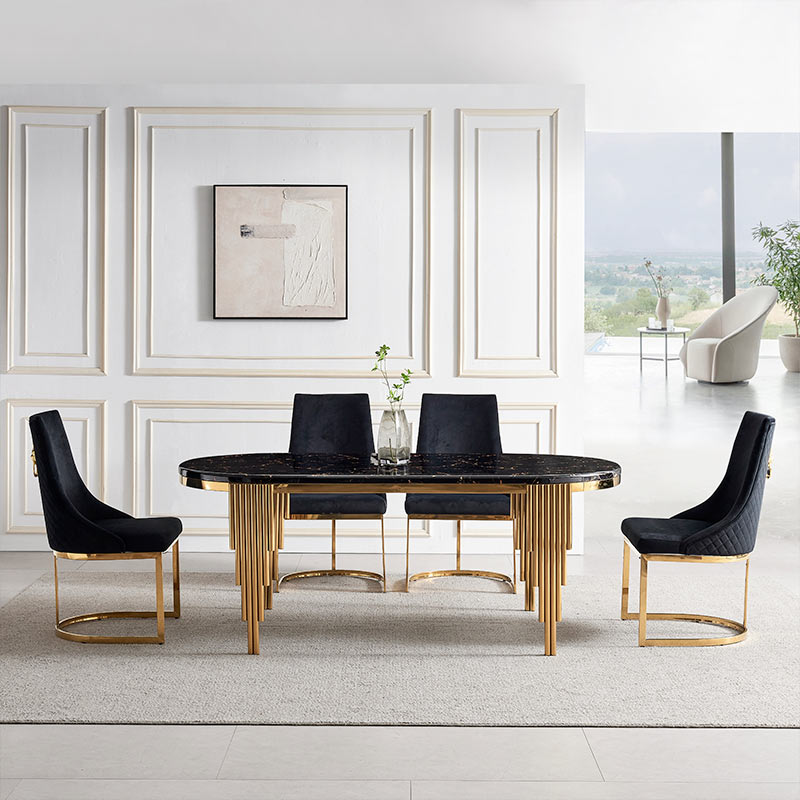How To Build A Dining Room Chair?
Building a dining room chair is both an art and an engineering process. Each step — from design conception to the final finishing touch — requires precision, aesthetic awareness, and a deep understanding of ergonomics. A well-built chair is more than a seat; it’s a balance between structure, comfort, and style that enhances the dining space and reflects quality craftsmanship.
This article provides a comprehensive look at how Dining Chairs are built, with emphasis on customization, design flexibility, and production quality. The process outlined here demonstrates what goes into producing chairs that are durable, stylish, and tailored for diverse furniture projects.
1. Understanding the Design Foundation
Every successful dining chair begins with a clear design vision. The design process integrates comfort, style, proportion, and functionality — ensuring the final product fits seamlessly with any dining environment.
a) Defining the Design Intent
Before any material is cut, designers determine:
The aesthetic direction — modern minimalist, classic wood, Scandinavian, or upholstered elegance.
The functional purpose — residential dining, restaurant use, or hospitality-grade durability.
The target height and proportions — ensuring harmony with standard Dining Tables (usually 28–30 inches high).
b) Ergonomic Considerations
A well-designed chair must accommodate the human body naturally:
Seat height: 17–19 inches from the floor for optimal comfort.
Seat depth: 15–18 inches to support the thighs without cutting circulation.
Backrest angle: Slightly reclined (around 100°–105°) for relaxed dining posture.
Armrest height: If applicable, they should fit under the table edge without obstruction.
Every curve and joint is measured to deliver lasting comfort — a critical detail in high-quality chair design.
2. Choosing the Right Materials
Material selection determines not only the appearance but also the longevity and structural integrity of the chair. For custom-built furniture, materials are chosen based on design goals, usage intensity, and environmental factors.
a) Wood
Solid wood remains the cornerstone of premium dining chairs. Common options include:
Oak: Dense, durable, and ideal for traditional styles.
Ash: Flexible with a fine grain, perfect for curved backrests.
Beech: Smooth and uniform, widely used in bentwood designs.
Walnut: Rich color and luxury appeal for premium interiors.
Each piece of timber is kiln-dried to reduce moisture content, preventing warping and cracking over time.
b) Metal
For modern and industrial aesthetics, stainless steel, iron, or aluminum is used for frames and legs. Metal offers superior strength and slim-line profiles, allowing sleek designs with stable support.
c) Upholstery and Padding
Fabric and leather upholstery add comfort and visual warmth. Options include:
High-density foam: Provides resilience and long-term comfort.
Genuine leather or PU leather: Combines elegance with easy maintenance.
Performance fabrics: Resist stains and fading — ideal for restaurants or hotels.
d) Finishes and Coatings
Protective coatings like water-based lacquer, powder coating, or oil finish ensure resistance to humidity, scratches, and daily wear. The chosen finish also enhances the material’s natural beauty, giving each chair a distinctive tone and texture.
3. Precision Crafting of Chair Components
A dining chair is composed of multiple parts: the legs, seat, backrest, and sometimes armrests. Each element must be crafted with precision to ensure seamless assembly and stability.
a) Frame Construction
The frame is the structural core of the chair. Using CNC cutting or manual joinery, wood or metal components are shaped with tight tolerances. Joints such as mortise-and-tenon or dowel-and-glue provide long-lasting rigidity without visible screws.
b) Shaping the Backrest
The backrest defines the chair’s personality and comfort level. Modern techniques like steam bending or laminated curve molding allow natural materials to form ergonomic contours that follow the human spine.
c) Seat Base Fabrication
Seats are typically made from solid panels, slats, or plywood bases topped with foam. For upholstered seats, the base is wrapped in padding and covered with carefully stretched fabric to avoid wrinkles and sagging.
d) Armrest Assembly (Optional)
Armrests are designed to match both function and style. Whether curved wood or metal extensions, they are attached using reinforced brackets or mortised joints for secure balance.
Each part is checked for dimension accuracy before final assembly, ensuring perfect alignment during production.
4. Assembling the Dining Chair
The assembly phase is where craftsmanship meets precision engineering. A skilled technician aligns and joins each component to ensure stability, balance, and long-term durability.
Step 1: Dry Fitting
All components are temporarily fitted together to check alignment and joint integrity. Any uneven surfaces are adjusted manually for a flawless fit.
Step 2: Gluing and Fastening
High-strength wood glue or industrial adhesive bonds the joints. Depending on the design, additional dowels, screws, or bolts reinforce load-bearing areas.
Step 3: Leveling
After assembly, chairs are leveled using precision equipment to guarantee even leg length and stable seating on any surface.
Step 4: Sanding and Surface Preparation
Once the frame is set, every edge is sanded smooth to remove imperfections. For wood chairs, fine sanding (up to 400 grit) ensures a soft touch and perfect finish absorption.
Step 5: Finishing and Polishing
Finishes are applied in layers, with hand-rubbing between coats to achieve a smooth, luminous sheen. This stage highlights craftsmanship and enhances resistance to stains, heat, and moisture.
5. Upholstery and Cushion Integration
For upholstered dining chairs, this stage transforms the frame into a piece of comfort and elegance.
a) Padding Application
High-resilience foam or layered cushioning is adhered to the seat and backrest. The thickness is chosen based on the design — slimmer for contemporary profiles and thicker for luxury dining chairs.
b) Fabric Cutting and Stitching
Each piece of fabric is measured and cut precisely to maintain symmetry and pattern consistency.
Edges are stitched and reinforced to prevent fraying or stretching during long-term use.
c) Upholstery Mounting
The fabric is stretched evenly over the padding and stapled or tacked on the underside. Skilled upholsterers ensure consistent tension across all surfaces for a flawless appearance.
d) Decorative Details
Custom details like piping, tufting, or button accents add personality to the design. These fine touches elevate the chair’s aesthetic and emphasize handcrafted quality.
6. Quality Control and Testing
Every dining chair must undergo rigorous quality checks before leaving the workshop. These inspections ensure that each unit not only looks refined but also performs perfectly under real-world conditions.
a) Structural Testing
Chairs are tested for load capacity and balance. The frame must support at least 250–300 pounds without deformation.
b) Surface Inspection
Finishes are examined for uniformity, smoothness, and resistance to scratches or stains. Any imperfections are refinished by hand.
c) Upholstery Evaluation
Fabric tension, stitching, and alignment are checked to maintain both comfort and aesthetics.
d) Stability Verification
The chair is placed on multiple surfaces to ensure no wobbling or unevenness.
Precision leveling is key to ensuring consistent performance in hospitality environments.
These quality control steps reflect a commitment to craftsmanship, durability, and user satisfaction — essential hallmarks of premium dining furniture.
7. Customization: Bringing Client Visions to Life
One of the most significant strengths in modern furniture manufacturing is the ability to customize.
Dining chairs can be tailored to match specific aesthetic preferences, spatial layouts, and brand identities.
a) Custom Dimensions
Clients may specify non-standard seat heights, wider seating surfaces, or modified back angles to suit particular dining table sizes or comfort requirements.
b) Material Combinations
Mixing materials — such as a metal frame with wooden seat, or upholstered backrest with rattan details — creates unique visual contrasts that align with brand or interior design themes.
c) Fabric and Color Matching
From neutral earth tones to bold modern palettes, every fabric and finish is matched to the client’s vision. Multi-layer finishing allows for matte, gloss, or textured appearances.
d) Branding Integration
Corporate or hospitality clients can request engraved logos, embroidered stitching, or signature trims, turning functional furniture into customized design statements.
Custom production not only reflects craftsmanship but also demonstrates adaptability — a key factor in meeting diverse market demands worldwide.
8. Sustainability and Environmental Responsibility
Today’s furniture manufacturing emphasizes eco-friendly materials and sustainable production. The goal is to reduce waste, minimize carbon footprint, and create long-lasting furniture that respects the environment.
Certified timber sourcing: Wood used in dining chairs often comes from FSC-certified forests.
Low-VOC finishes: Eco-friendly coatings reduce harmful emissions.
Recyclable components: Metal and upholstery materials are selected for long-term recyclability.
Energy-efficient production: Modern machinery and controlled waste management ensure reduced environmental impact.
Sustainability isn’t a trend — it’s a core value that enhances both the ethical and practical appeal of custom furniture.
9. Final Inspection and Packaging
Before shipping, every chair undergoes a final quality check and protective packaging process.
Final polish: Surfaces are cleaned and buffed for showroom presentation.
Protective wrapping: Bubble film, foam padding, and corner guards prevent transit damage.
Carton or pallet packing: Each chair is securely packed according to international shipping standards.
Batch verification: Serial codes and inspection reports are attached for traceability.
Attention to packaging details reflects the same care given to production — ensuring each chair arrives in pristine condition, ready for installation.
Conclusion
Building a dining room chair is a meticulous process that combines design creativity, material expertise, and precise craftsmanship. From the initial sketch to the final polish, every phase contributes to creating a chair that not only meets ergonomic standards but also expresses timeless beauty and quality.
A well-crafted chair should tell a story — of thoughtful design, skilled construction, and enduring comfort. If you need to custom dining room chairs, please contact us for more details.
Previous: How To Build A Dining Room Table




